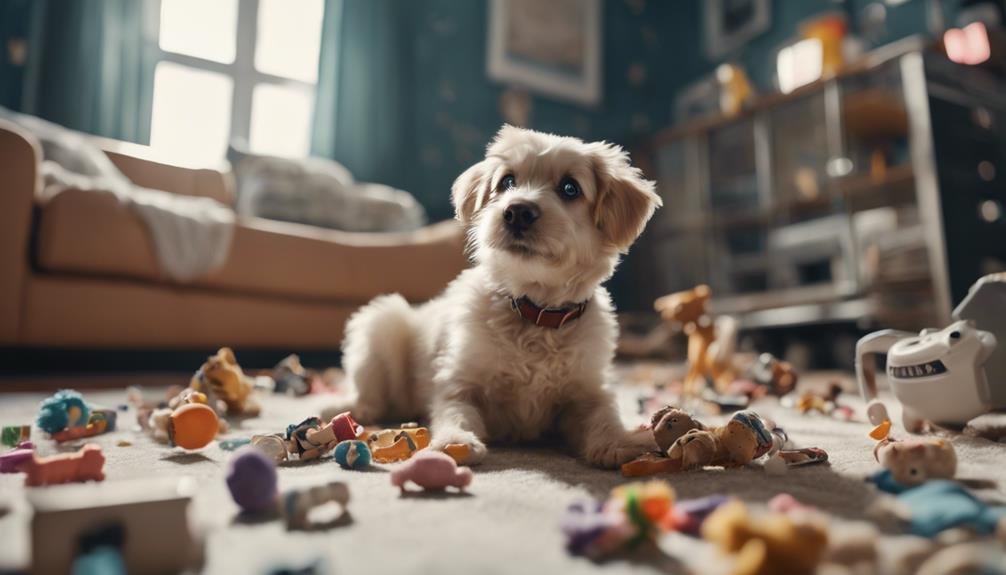Effective puppy training requires a tailored approach, acknowledging that each dog develops at their own pace. A one-size-fits-all approach can hinder progress, leading to frustration and stagnation. Unrealistic expectations and premature acceleration can cripple the learning process. Instead, focus on building a solid foundation through basic obedience, socialization, and leash training. A patient and calm demeanor is essential, as emotional intelligence creates a conducive learning environment. Celebrating small wins and adapting to individual differences fosters a strong bond and accelerates learning. Discover how embracing these principles can revolutionize your puppy training experience.
Key Takeaways
- Avoid unrealistic expectations and celebrate small wins to build momentum and reinforce positive behaviors in puppies.
- A patient and calm approach is crucial in puppy training, as rushing the process can be detrimental to progress.
- Focus on building a solid foundation in basic obedience and leash work before advancing to complex tasks.
- Recognize that every dog is unique, with individual strengths, weaknesses, and learning styles, and adapt training methods accordingly.
- A trainer's emotional state affects the puppy's emotional state, so it's essential to manage emotions and create a positive learning environment.
Keep Training Wheels On Tight
During the critical six-month mark, puppies should be focused on mastering basic obedience and leash work, rather than being pushed into advanced training, as premature acceleration can hinder their long-term development. This stage is vital for building a solid foundation, and rushing into complex tasks can be detrimental. Breed differences aside, puppy socialization is also vital during this period. Recognize that puppies develop at their own pace, and forcing them into advanced training can be disastrous. By focusing on the basics, puppies can build problem-solving skills and learn behaviors necessary for more complex tasks. This patient approach guarantees a strong foundation, allowing puppies to excel in the long run.
No Rush to Grow Up
A puppy's developmental timeline is often misunderstood, leading many trainers to rush their charges into advanced training prematurely, neglecting the essential process of gradual skill acquisition. This misconception stems from a lack of understanding of a puppy's slow maturity. Gentle guidance is vital during this phase, as puppies need time to build problem-solving skills and learn behaviors necessary for more complex tasks. Forcing advanced training can be disastrous, as it disregards the puppy's natural pace of development. By adopting a patient approach, trainers can foster a strong foundation, allowing puppies to progress at their own pace. This slow and steady approach guarantees a more stable and lasting learning process.
Puppies Need Their Own Pace
Every puppy develops at an individual pace, and attempting to impose a standardized timeline on their growth can lead to frustration, stagnation, and even regression. Puppies, like humans, have unique developmental paths, and slow development does not necessarily indicate a lack of potential. In fact, puppy milestones are often reached at varying ages, and a one-size-fits-all approach can hinder progress.
| Puppy Age | Typical Milestones |
|---|---|
| 8 weeks | Basic obedience, socialization |
| 12 weeks | Leash training, basic commands |
| 16 weeks | Advanced obedience, problem-solving |
| 20 weeks | Complex tasks, refining skills |
| 24 weeks | Mastery of foundational skills |
Unrealistic Expectations Harm
Unrealistic expectations can be a crippling burden on the puppy training process, as they can lead to undue stress, frustration, and disappointment for both the puppy and the trainer. High expectations can create puppy pressure, causing the puppy to feel overwhelmed and anxious. This pressure can hinder the learning process, leading to decreased motivation and performance. In addition, unrealistic expectations can lead to frustration and disappointment when the puppy fails to meet the desired standards. It is essential to have realistic goals and acknowledge that puppies develop at their own pace. By doing so, trainers can create a positive and supportive learning environment, allowing puppies to thrive and reach their full potential.
Trainer's Emotions Matter Most
Six key factors influence the success of puppy training, and one of the most critical, yet often overlooked, elements is the emotional state of the trainer. A trainer's emotional intelligence and calming presence can profoundly impact the puppy's behavior and progress.
- A trainer's emotional state can affect the puppy's emotional state, leading to either a positive or negative learning environment.
- Trainers with high emotional intelligence can better understand and manage their emotions, creating a more conducive learning environment.
- A calming presence can help reduce puppy anxiety, increasing their ability to focus and learn.
- Trainers must recognize and manage their emotions to avoid transferring negative emotions to the puppy.
- By maintaining a calm and patient demeanor, trainers can foster a positive and productive learning environment.
Small Wins Are Big Deals
One of the most significant advantages of focusing on small wins is that it allows trainers to build momentum and reinforce positive behaviors in their puppies. Celebrating milestones, no matter how small, is essential in puppy training. It not only reinforces desired behaviors but also builds confidence in both the puppy and the trainer. By acknowledging and rewarding small achievements, trainers can create a positive feedback loop that fosters a strong bond between the puppy and the trainer. This, in turn, accelerates the learning process, as puppies become more receptive to training. By recognizing and celebrating small wins, trainers can create a solid foundation for further learning, laying the groundwork for more complex behaviors and tasks.
Patience Is a Virtue Here
In the domain of puppy training, tolerance is a crucial element that separates successful trainers from those who struggle to make progress with their puppies. A patient trainer understands that puppies develop at their own pace, and rushing the process can be detrimental to their progress.
- Calm communication and gentle guidance are essential in puppy training, allowing puppies to feel comfortable and build trust with their trainers.
- A patient trainer can observe and respond to a puppy's cues, fostering a stronger bond and more effective learning.
- Impatience can lead to frustration, anxiety, and even fear in puppies, hindering their ability to learn.
- Patience allows trainers to focus on small, achievable goals, celebrating small wins and building confidence in both the puppy and trainer.
- By embracing patience, trainers can create a nurturing environment that promotes healthy growth and development in their puppies.
Don't Force the Training Fit
Many puppy training approaches fail to recognize that every dog is unique, with individual strengths, weaknesses, and learning styles. This oversight can lead to a "one-size-fits-all" approach, which neglects puppy personalities, training styles, and learning curves. Breed differences, environmental factors, and puppy proofs further complicate the training process. Forcing a puppy into a predetermined training mold can be disastrous, stifling their natural abilities and creating frustration. Instead, trainers should adapt their methods to accommodate the puppy's unique characteristics, allowing them to grow at their own pace. By acknowledging and respecting individual differences, trainers can create a tailored approach that fosters a strong, healthy relationship between puppy and trainer, ultimately leading to successful training outcomes.
Frequently Asked Questions
How Can I Avoid Overexerting My Puppy During Training Sessions?
To avoid overexerting your puppy during training sessions, monitor for signs of puppy fatigue, such as yawning, panting, or disengagement, and incorporate regular training breaks to allow for mental and physical recovery, ensuring effective learning and preventing burnout.
What's the Ideal Age to Start Teaching Complex Obedience Commands?
"As the adage goes, 'you can't build a house without a foundation.' Ideal timing for complex obedience commands depends on brain development and socialization period, typically between 12-16 weeks, when puppies are most receptive to learning and social cues."
Can I Still Train My Puppy if I Have a Busy Schedule?
Busy schedules don't preclude puppy training; effective time management and leveraging resources like puppy sitters can facilitate consistent training, ensuring puppies receive necessary socialization and skills development despite owners' limited availability.
How Do I Prevent My Puppy From Getting Bored During Repetitive Training?
To prevent boredom during repetitive training, incorporate mental stimulation and sensory play, such as scent work, hide-and-seek, and interactive toys, to engage your puppy's cognitive and sensory abilities, promoting focus and reducing monotony.
What's the Best Way to Correct My Puppy's Mistakes Without Discouraging Them?
When correcting puppy mistakes, employ gentle correction techniques to avoid discouragement, leveraging positive reinforcement to instill confidence, as punitive methods can lead to fear and hinder learning, emphasizing empathy and patience in the training process.
Conclusion
In summary, a puppy's training trajectory is akin to a delicate botanical bloom, where premature exposure to intense stimuli can be detrimental to growth. Research suggests that puppies forced to mature too quickly are more likely to exhibit anxiety and fear-based behaviors (Bekoff, 2002). By adopting a patient and nuanced approach, trainers can cultivate a strong foundation, yielding a resilient and well-adjusted canine companion.









